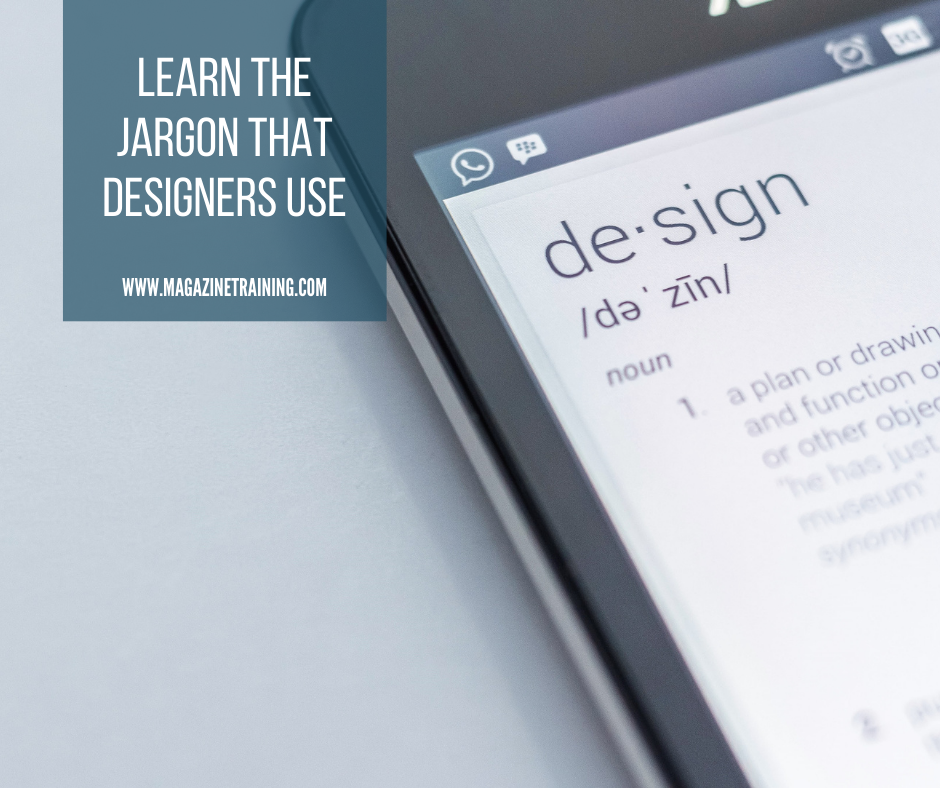
Designers have various terms and jargon that go with the profession. Here are just a few of the commonly used terms and their definitions.
architecture: Underlying structure of a page.
asymmetry: Disproportion; lack of symmetry.
bleed: Type or imagery that extends beyond the trim edge of a page.
byline: Author’s credit line.
CMYK values: CMYK refers to the four-color printing process inks. C=cyan, M=magenta, Y=yellow, and K=black. CMYK values refers to the combination of percentages of each color. For example, true red is 100% magenta and 100% yellow.
color palette: The selection of colors or hues that will be used exclusively or regularly in the magazine.
contrast: The relative difference between elements on a page or spread. May refer to tonality, color, texture, or size.
corner splash: A triangle of color in the upper right or bottom right of the cover containing special editorial content.
design parameters: The self-imposed boundaries of the design to ensure the integrity of the style and personality of the magazine, such as a limited range of typefaces and colors.
display text: Refers to headlines or other text intended to draw the reader into the article.
eyebrow line: Short, pithy blurbs which give readers a quick look at a magazine’s content; mostly placed above the name plate.
focal point: The primary and specific area within a composition or design to which attention is drawn.
format: General appearance or style of a publication including its size, shape, paper quality, typeface and binding.
grid: A measuring guide used by designers to help ensure consistency. The grid shows type widths, picture areas, trim sizes, margins, etc.
gutter: The inside margin where two pages of a publication join.
hierarchy: Relative importance of objects on a page.
house sheet: Paper a printer keeps in stock and buys in large quantity.
limited palette: The self-imposed restrictions on choices for design elements such as typefaces and colors.
master pages: In Quark Xpress, InDesign, or any page layout program, master pages serve in a similar capacity as templates. Users can create master pages for frequently used elements such as folios, text columns, and ruled borders. More complex master pages may be created for departments and features. Then, the user can drag and drop them into documents without having to recreate the repeating elements.
negative space: The empty space created on a page by the placement of type and imagery. Awareness and use of this element is an important, but often overlooked, design consideration.
rivers: Streaks of white spacing in the text, produced accidentally when spaces in consecutive lines of type coincide.
screen: Uniform crisscross lines which break an image into a pattern of dots which, in turn, simulate gradations of gray.
second color: When using only black and another color in printing, this refers to the other color.
sidebar: A short article related to the main article and placed next to it.
standing head: A headline used in every issue with a regular column or department.
symmetry: Similarity of form or arrangement on either side of the dividing line of a plane; correspondence of opposite parts in size, shape, and position.
teasers: Another way to refer to pull-quotes—any piece of text pulled from an article to highlight some main point or to draw readers in. They are often quotes, but may be any piece of compelling editorial.
utilities (referring to the magazine cover): UPC codes and address labels placed on the cover, which require special design attention to ensure the necessary space is available.
well: Refers to the section in a magazine containing the feature articles.
Purchase one of our manuals that cover writing, design, management, and editing. Each manual contains an extensive glossary of terms.
Related posts
Magazine Training International’s mission is to encourage, strengthen, and provide training and resources to Christian magazine publishers as they seek to build the church and reach their societies for Christ.

